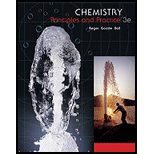
Concept explainers
(a)
Interpretation:
Lewis structure for
Concept Introduction:
Lewis structure is used for predicting the shape of molecules. From the steric number obtained in a Lewis structure, the molecular geometry can be predicted. VSEPR model can predict the shape of molecules considering their Lewis structure. Certain rules has to be followed in for the VSEPR model.
- The molecule will have a shape where there is minimal electrostatic repulsion between the valence‑shell electron pairs.
- The forces of repulsion between two lone pairs of electrons will be higher than the repulsion between lone pair and bond pair of electrons. This in turn will be higher than the bond pair‑bond pair of electrons.
(a)
Explanation of Solution
Lewis structure for
The total number of valence electrons present in
The skeletal structure can be drawn considering the formula as shown below;
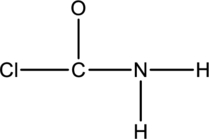
Ten electrons are used up in the skeletal structure. Among the remaining fourteen valence-electrons, six are placed over chlorine atom and six are placed over oxygen atom. Two electrons are placed over nitrogen atom.

Thus the Lewis structure of
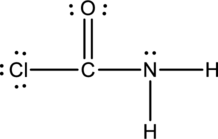
Bond Angles:
There is a carbon atom and a nitrogen atom as central atom in the Lewis structure. The steric number of the central atom can be used to predict the bond angles of the central atoms.
Steric number for carbon
The number of lone pair of electrons on carbon atom is zero while the number of atoms that are bonded to carbon is three. Therefore, steric number can be calculated as shown below;
As the steric number is three, and only bonding pair of electrons are present, the arrangement is trigonal planar and the bond angle will be
Steric number for nitorgen atom:
The number of lone pair of electrons on nitrogen atom is one while the number of atoms that are bonded to nitrogen is three. Therefore, steric number can be calculated as shown below;
As the steric number is four, the arrangement is tetrahedral and the bond angle will be
(b)
Interpretation:
Lewis structure for
Concept Introduction:
Refer part (a).
(b)
Explanation of Solution
Lewis structure for
The total number of valence electrons present in
The skeletal structure can be drawn considering the formula as shown below;
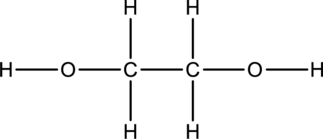
Eighteen electrons are used up in the skeletal structure. Among the remaining eight valence-electrons, four are placed over oxygen atom each. Thus the Lewis structure for
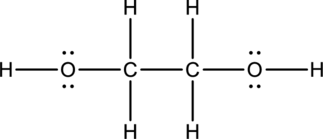
Bond Angles:
There are two carbon atoms as central atoms in the Lewis structure. The steric number of the central atom can be used to predict the bond angles of the central atoms.
Steric number for carbon atom:
The number of lone pair of electrons on carbon atom is zero while the number of atoms that are bonded to carbon is four. Therefore, steric number can be calculated as shown below;
As the steric number is four, the arrangement is tetrahedral and the bond angle will be
(c)
Interpretation:
Lewis structure for
Concept Introduction:
Refer part (a).
(c)
Explanation of Solution
Lewis structure for
The total number of valence electrons present in
The skeletal structure can be drawn considering the formula as shown below;

Six electrons are used up in the skeletal structure. Among the remaining twelve valence-electrons, six are placed over nitrogen atom each. Thus the Lewis structure for

Bond Angles:
There are two carbon atoms as central atoms in the Lewis structure. The steric number of the central atom can be used to predict the bond angles of the central atoms.
Steric number for carbon atom:
The number of lone pair of electrons on carbon atom is zero while the number of atoms that are bonded to carbon is two. Therefore, steric number can be calculated as shown below;
As the steric number is two, the arrangement is linear and the bond angle will be
Want to see more full solutions like this?
Chapter 10 Solutions
Chemistry
- What is the lewis dot structrue for C2H3O2Clarrow_forwardWhat is the electron-pair geometry around the central S atom in sulfuryl fluoride, SO2F2?arrow_forwarda) Methane 1CH42 and the perchlorate ion 1ClO4- 2 are both described as tetrahedral. What does this indicate about their bond angles? (b) The NH3 molecule is trigonal pyramidal, while BF3 is trigonal planar. Which of these molecules is flat?arrow_forward
- (a) Methane (CH4) and the perchlorate ion (ClO4- ) are bothdescribed as tetrahedral. What does this indicate about theirbond angles? (b) The NH3 molecule is trigonal pyramidal, while BF3 is trigonal planar. Which of these molecules is flat?arrow_forwardwhat are the bond angles of AsF4Br relative to AsF5? and why? how do the molecule structures differ?arrow_forwardWhat is the electron geometry and molecular geometry of C2H4O?arrow_forward
- In each of the following molecules, a central atom is surrounded by a total of three atoms or unshared electron pairs: SnCl2, BCl3, SO2. In which of these molecules would you expect the bond angle to be less than 120? Explain your reasoning.arrow_forwardIdentify the type of hybridization, approximate bond angles for the N, C, and O atoms, and shortest carbon-to-oxygen bond length in alanine, an amino acid, whose Lewis structure isarrow_forwardThe cyclohexane carboxylate anion has a Lewis structure Pushing a pair of unshared electrons away from the negatively charged oxygen atom and, at the same time, pushing a pair of pi electrons toward the other oxygen will generate a second resonance structure. Thus,arrow_forward
 Chemistry: Principles and PracticeChemistryISBN:9780534420123Author:Daniel L. Reger, Scott R. Goode, David W. Ball, Edward MercerPublisher:Cengage Learning
Chemistry: Principles and PracticeChemistryISBN:9780534420123Author:Daniel L. Reger, Scott R. Goode, David W. Ball, Edward MercerPublisher:Cengage Learning Chemistry: The Molecular ScienceChemistryISBN:9781285199047Author:John W. Moore, Conrad L. StanitskiPublisher:Cengage Learning
Chemistry: The Molecular ScienceChemistryISBN:9781285199047Author:John W. Moore, Conrad L. StanitskiPublisher:Cengage Learning Introductory Chemistry: An Active Learning Approa...ChemistryISBN:9781305079250Author:Mark S. Cracolice, Ed PetersPublisher:Cengage Learning
Introductory Chemistry: An Active Learning Approa...ChemistryISBN:9781305079250Author:Mark S. Cracolice, Ed PetersPublisher:Cengage Learning
 Chemistry & Chemical ReactivityChemistryISBN:9781133949640Author:John C. Kotz, Paul M. Treichel, John Townsend, David TreichelPublisher:Cengage Learning
Chemistry & Chemical ReactivityChemistryISBN:9781133949640Author:John C. Kotz, Paul M. Treichel, John Townsend, David TreichelPublisher:Cengage Learning Chemistry: Principles and ReactionsChemistryISBN:9781305079373Author:William L. Masterton, Cecile N. HurleyPublisher:Cengage Learning
Chemistry: Principles and ReactionsChemistryISBN:9781305079373Author:William L. Masterton, Cecile N. HurleyPublisher:Cengage Learning





